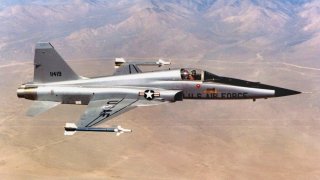Swiss F-5 Fighters Get Second Life with U.S. Marine Corps
The venerable Northrop F-5, a supersonic light fighter developed during the Cold War, continues to find a place in modern military operations, particularly within the U.S. Marine Corps. Despite the end of its production in 1989, the U.S. military has found the F-5 to be invaluable for training and adversary squadron roles, simulating enemy aircraft in aerial combat.
Summary: The venerable Northrop F-5, a supersonic light fighter developed during the Cold War, continues to find a place in modern military operations, particularly within the U.S. Marine Corps. Despite the end of its production in 1989, the U.S. military has found the F-5 to be invaluable for training and adversary squadron roles, simulating enemy aircraft in aerial combat. Recently, the Marine Corps has sought to bolster its fleet of F-5s by acquiring 22 retired Tigers from the Swiss Air Force for around $1.5 million each. These aircraft will serve in adversarial roles, a testament to their enduring utility.
F-5 Tigers: From Swiss Alps to US Marines, A Journey of Enduring Valor
During the Cold War, more than 2,500 Northrop F-5 supersonic light fighters were produced for the United States and its allies. It was one of the aviation firm's most enduring military aircraft designs, and even it has remained in service for nearly five decades. Though production ended in 1989 – with it being unique in that every aircraft was delivered on schedule, and at or below contract price – the U.S. military continues to maintain a fleet of F-5s.
Those aircraft have proven well-suited for use in training and with its adversary squadrons with both the U.S. Navy and U.S. Air Force to simulate enemy aircraft in aerial combat.
In fact, even though that the Northrop F-5 took its first flight more than 65 years ago and is far from a cutting-edge fighter, it is quite the "in-demand" aircraft – and this month the United States Marine Corps announced plans to acquire 22 retired F-5 Tigers from the Swiss Air Force.
According to a report from the AVWeb.com, the Marine Corps paid around $1.5 for each of the Cold War fighters, while the first one was stripped down and loaded on a C-130 transport earlier this month for its trip back to the United States. As with the U.S. Navy's and U.S. Air Force's F-5s, it will be used as an adversarial aircraft, as will the other Tigers now being caged up for transport.
Switzerland received its fleet of F-5s in the 1970s and 1980s and previously sold some of its retired aircraft to the U.S. Navy. However, Bern will still reportedly retain at least a few F-5s for use with the Swiss Air Force's air demonstration team, the Patrouille Suisse.
Secondhand F-5 Tigers
It is also worth noting that this is not the first time the Marine Corps has sought to acquire F-5s from nations that have retired the old warbird. As TheWarZone reported in 2017, the Marine Corps attempted to procure secondhand Tigers from around the globe to bolster its aggressor ranks.
At the time, the USMC was even setting up F-5 detachments at multiple bases.
The National Interest's Maya Carlin also reported that the F-5 has played a significant role in training some of the most prolific pilots in the modern era, including those in the Heritage Flight program.
"Capable of reaching speeds of Mach 1.63 with a range of 554 miles, the F-5 was an Air Force favorite. The fighter could climb at a rate of around 35,000 feet per minute and could sport two 20mm M39A2 Revolver cannons," wrote Carlin. "Although the jet was intended to function as a day air superiority airframe, its ground-attack capabilities also highlighted the F-5's versatility."
Along with that versatility, the F-5's relatively low-cost maintenance made it a prime candidate for export when it was first introduced, and those attributes are why the aircraft is so desired now by the Marine Corps. In other words, it is an ideal aircraft for training and can serve in an adversarial role.
Old Warbird With New Hardware
The F-5 has also proven to be quite adaptable, and in 2022, the Garmin G3000 integrated flight deck was selected for the U.S. Navy and U.S. Marine Corps F-5 aircraft modernization program. The commercial-off-the-shelf (COTS) G3000 open architecture supports integration of a wide range of mission equipment including military sensors, helmet-mounted displays, and advanced electrically scanned radar systems.
It further boasts a high-resolution flight display that can be interfaced with the F-5's existing mission computer, enabling advanced mapping, tactical radio capabilities, radar display, and more. It provided the aging warbird with 21st-century technology, ensuring that Cold War-era supersonic, multi-role tactical fighter and attack aircraft could continue to prepare pilots for the latest fighters they might be flying.
Author Experience and Expertise: Peter Suciu
Peter Suciu is a Michigan-based writer. He has contributed to more than four dozen magazines, newspapers, and websites with over 3,200 published pieces over a twenty-year career in journalism. He regularly writes about military hardware, firearms history, cybersecurity, politics, and international affairs. Peter is also a Contributing Writer for Forbes and Clearance Jobs. You can follow him on Twitter: @PeterSuciu. You can email the author: [email protected].


